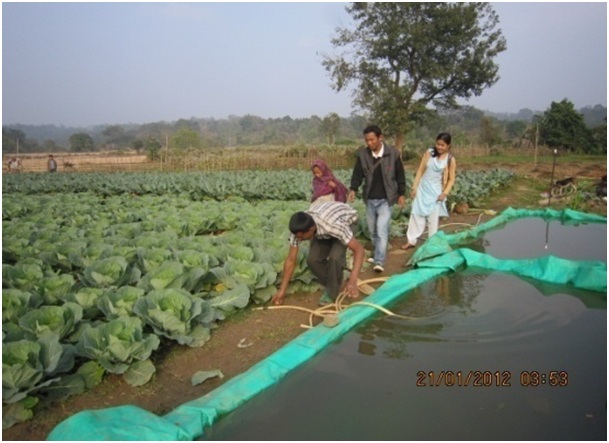SUCCESS STORIES OF KVK FROM ICAR-ATARI (Zone-III)
Name of the KVK, West Garo Hills (Meghalaya)
Rain water harvesting ( Jalkund ) boosts yield for winter vegetables crops
A.S. Singh, Tarun Kumar Das, N. Arunkumar Singh & Tanmay Samajdar
Krishi Vigyan Kendra, ICAR, West Garo Hills, Meghalaya
West Garo Hills district of Meghalaya receives an annual rainfall of about 2800 mm and more but still there is scarcity of water during the rabi season for cultivation of vegetables as the local farmers do not stored water for future purposes. Tribal farmers are using streams and ponds for cultivation of vegetables in small areas. Due to shortage of water, majority of the local farmers do not go for rabi crop cultivation any during the rabi season.
KVK intervention
Under the project National Initiative on Climate Resilient (NICRA), of Krishi Vigyan Kendra, ICAR Research Complex for NEH Region, Tura assessed the water related problems in Marapara village of Dalu block in West Garo Hills district ventured into popularizing low cost rain water harvesting structure (Jalkund) for harvesting of rain water during the rainy season and its subsequent use during dry periods. Due to acute shortage of water, a huge area of land in the village was kept fallow during rabi season. In order to overcome the problem, KVK, West Garo Hills constructed 5nos. of Jalkunds of size (5x 4x 1.5m) using low cost raw materials like pond line HDPE Silpaulin in the village. Each Jalkund having a storing capacity of 30,000 litres of water. In addition, seeds and planting materials of some winter vegetables were also distributed to the farmers. Before implementation of the intervention, most of the farmers depend their livelihood only on the farm produce during kharif season but the problems has been solved as KVK, Tura has provided lifesaving irrigation to the crops and drinking water.Achievement
Mrs. Pronila Sangma, a progressive farmer of Marapara village used the intervention and store the rain water during the rainy season and which was utilized in the rabi season where she raises the nursery of vegetables and sold @ Rs.1/- per seedling in the village and also from her crop produce she earn a monetary return of Rs.1,07,500.00 .
The crop production and its benefit from water harvested structure during the rabi season was utilized for 3 months at the rate of 25lt/day for irrigating vegetable crops and the details as shown below:
Table: Production and income generated from vegetable cultivation using jalkund
Sl. No.Name of the Crops
Production (Quintal)
Sold @/Kg
Gross cost (Rs)
Gross return (Rs)
Net Return (Rs.)
B:C ratio
1.
Cauliflower
8.5
20
6460
17,000
10540
2.63
2.
Brocolli
6.5
20
4680
13,000
8320
2.7
3.
Cabbage
10
10
4460
10,000
5540
2.24
4.
Knolkhol
5
20
3500
10,000
6500
2.85
5.
Radish
20
10
6900
20,000
13100
2.89
6.
Leafy vegetables
3,150 bundles
1@ Rs 10
12550
31,500
18950
2.5
9.
Tomato
3.0
20
2400
6,000
3600
2.5
Total
40950
107500
66550
2.62
Impact
By seeing the intervention,6 nos of farmers of the villages and nearby are motivated and started to adopt the technology.After introduce of Jalkund technology, the level of employment increases,maintains the living status of the famers and kept socialized with the neighbouring villagers.
